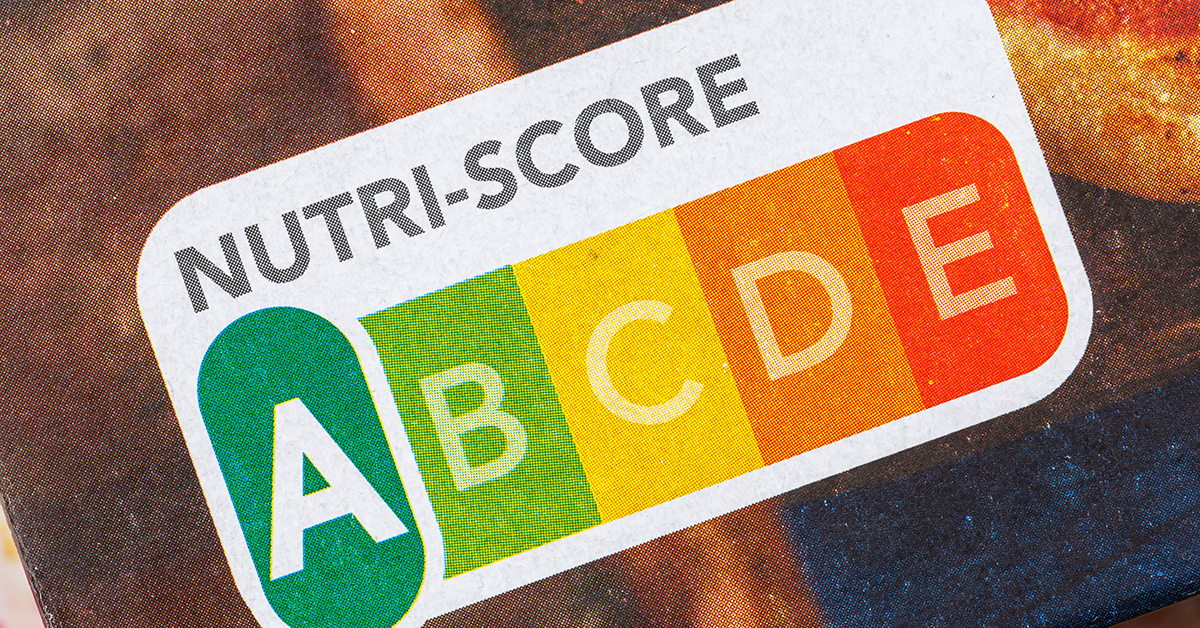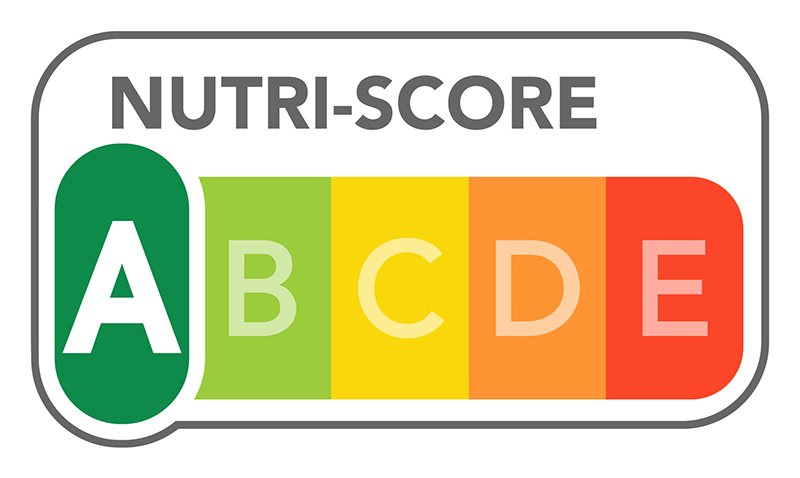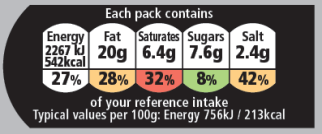
Nutri-Score vs Nutri-Mark? What are the differences in nutrition labelling schemes between the UK, EU and GCC?
21 May 2025 | Lewis Wallis, Regulatory Affairs Advisor, Lena Abdou, Regulatory Advisor, Sharon Morey, Regulatory Affairs Manager
Nutri-Score
Nutri-Score is a Front-of-Pack Nutrition Labelling (FoPNL) scheme designed to help consumers make informed food choices at a glance. The system evaluates the nutritional quality of food and beverage products, assigning them a grade from A (healthiest) to E (least healthy). Although the original model was based on the UK Nutrient Profiling Model (UK NPM) used to categorise products as HFSS, the approach contrasts with this binary output.
It uses a scoring algorithm to calculate the overall nutritional quality of products. The model has been revised (2022–2023) to reflect new dietary priorities and scientific evidence. For example:
- Negative points are now assigned to beverages containing non-nutritive sweeteners, reflecting concerns about their long-term health impacts.
- Adjustments have been made to the thresholds for certain nutrients, such as sugar, fat, and fibre, to better align with updated dietary guidelines.
Nutri-Score has been voluntarily adopted in seven European countries, including France, Germany, and Belgium. There have been calls for EU-wide adoption, which would standardise the label across all Member States. However, the proposal has been met with resistance from some countries, particularly those with culinary traditions reliant on high-fat or high-sugar products.

Nutri-Mark in UAE – what’s the difference?
The Abu Dhabi Quality and Conformity Council introduced mandatory nutrition labelling and for Nutri-Mark in Abu Dhabi. The measures aim to provide consumers with information about the healthy parameter content in Nutri-Mark, and to make more informed choices across consumable products and have healthier options to choose from.
It is expected that all products put on the Abu Dhabi Market after June-July 2025 which fall within the regulation requirements will require the Nutri-Mark label, whether they are manufactured within the UAE or outside of the UAE.
Nutri-Mark is a labelling system implemented in UAE that mirrors the Nutri-Score model in both method and thresholds. It assigns products to one of five letters (A–E) based on their overall nutritional score. There are five colour-coded grades for the Nutri-Mark. Grade A (dark green), a better food composition. Grade E (Dark Orange), a less favourable nutritional composition. The grade assigned to a food product depends on the type of Food, its nutritional value as well as its ingredients.
However, there are notable differences between the two systems:
- Mandatory vs. Voluntary
- Nutri-Mark: Mandatory with enforcement first of June 2025 for five product categories sold in Abu Dhabi, with plans to expand scope in the future.
- Nutri-Score: Voluntary implementation across some EU Member States
- Product Categories
- Nutri-Score can be applied to all products on a voluntary basis.
- Nutri-Mark focuses on specific priority categories, making compliance a legal requirement for products sold within the region.
The targeted categories are:
- Breads and pastries
- Food targeted to children
- Cooking oil
- Beverages
- Dairy products
At present only the above categories are expected to require mandatory Nutri-mark Front of Pack labelling, the remaining products being voluntary. This will be defined in the Regulatory document once issued.
Where does this leave traffic lights?
The Multiple Traffic Light (MTL) scheme is the UK's recommended FoPNL system. Unlike Nutri-Score or Nutri-Mark, it uses a colour-coded approach to highlight the levels of four key nutrients:
- Green: Low levels of fat, saturated fat, sugar, or salt
- Amber: Medium levels
- Red: High levels
MTL is voluntary in the UK and has been adopted by some countries in the Gulf Cooperation Council (GCC). Products in the GCC can still display MTL labels, but those sold in Abu Dhabi must comply with Nutri-Mark regulations if they fall within the mandatory product categories.

Summary table
| Aspect | Nutri-Score | Nutri-Mark | Traffic Lights (MTL) |
|---|---|---|---|
| Implementation | Voluntary in 7 EU countries | Mandatory in Abu Dhabi | Voluntary in the UK and GCC |
| Coverage | All products | Five categories (Breads and pastries, food targeted to children, cooking oil, beverages and dairy products with the intend to expand in the future) | All products |
| Label design | A–E letter grades | A–E letter grades | Green, amber, red for 4 nutrients |
How can we help?
As experts in food compliance and regulatory consultancy, we are fully equipped to support manufacturers and producers aiming to sell their products in the UAE market under the new Abu Dhabi Nutri-Mark requirements coming into effect in June 2025. Our services include assisting with regulatory compliance, guiding you through the Nutri-Mark certification process, and assessing your products to ensure they meet the required nutritional standards. We also offer expertise in front-of-pack nutrition labelling systems, including traffic light labelling and Nutri-Score, helping you align with international best practices and enhance consumer trust. We are committed to helping you navigate these changes smoothly and ensure your products are market-ready and fully compliant.

About Lewis Wallis
Lewis is a Regulatory and Nutrition Affairs Advisor in the Global Regulatory Affairs team at Campden BRI and has previous industry experience from working for a large multi-national company. He has contributed to and written material for a variety of outputs including research publications, technical reports, food law updates, blog articles, white papers, book chapters, eBooks and guidance documents. Lewis presents on Campden BRI courses and at a range of industry and academic events on the topics of High Fat Sugar Salt (HFSS) legislation, ultra-processed foods, and front-of-pack nutrition labelling.
He is a member of the IFST Food Regulatory Special Interest Group that work to host thought-provoking discussion workshops which feature experts presenting on the latest regulatory hot topics.
Alongside his current role, Lewis is a Postgraduate Researcher at University of Leeds and draws upon his regulatory expertise to conduct research at the intersection of food legislation and consumer behaviour, particularly focusing on measures designed to promote healthier and more sustainable food choices within digital food environments (e.g. online retail, meal delivery apps, social media). He has conducted research on the implementation of HFSS restrictions within online retail and his work involves the application of nutrient profiling models and processed food classification systems to products promoted and sold in digital settings.

About Sharon Morey
Sharon has worked here at Campden BRI since 2016, and also has a wealth of knowledge and experience from previous regulatory, technical and other roles.
Sharon studied Nutrition, and has previously worked at Quest NutraPharma (Regulatory Affairs Manager/ Nutritionist and Training Manager), BioCare Ltd (Technical and Customer Development Manager) and Holland & Barrett Ltd (Regulatory Affairs Officer/Retail Training Officer/ Customer Service Manager/Public Relations Officer).
Alongside supporting clients and projects within Regulatory Affairs, Sharon presents on scheduled and tailored training courses in all aspects of Food Law. She has also contributed to and written articles for nutritional and pharmaceutical trade and consumer publications.
Need advice?
Got a question related to the Abu Dhabi Nutri-Mark requirements, or any wider concerns around Front-of-Pack Nutrition Labelling (FoPNL) schemes?
Regulatory support
For more on our global regulatory support services, visit our service pages.







